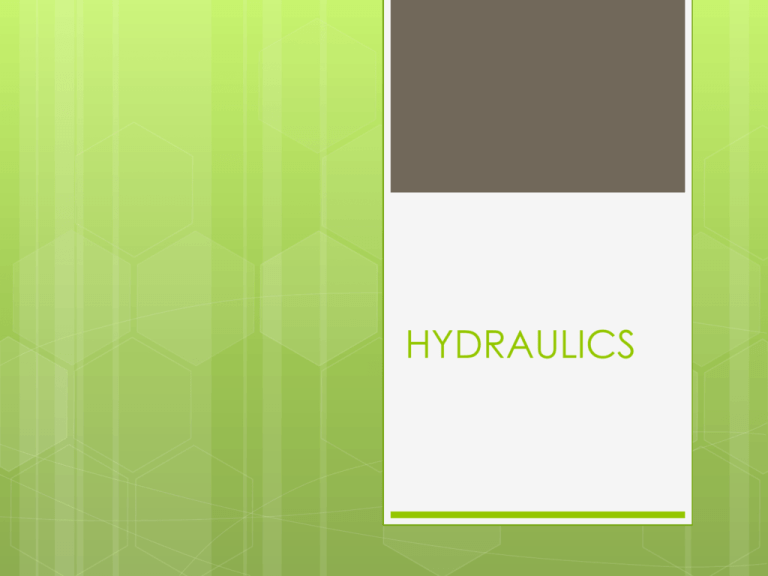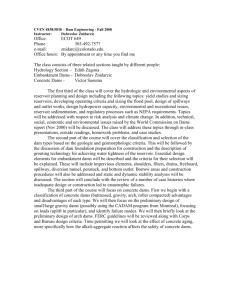dams
advertisement

HYDRAULICS Water is not only important for human beings but for all living creatures. It is the material that makes possible to maintain one’s life and additionally it is used in: Industry Cleaning (both for humans and environment) Fire control …. For having a healthy life and keeping the standards of living, the required amount and quality of water should be supplied. For this reason, the civil engineers and other researchers in many disciplines should study on water science. As vital for human life, the construction of water structures goes back to ancient times. The oldest water structure is not known. The oldest water structures known are located in Mesopotamia, central Asia, Egypt, India and China, the irrigation systems in the vicinity of main rivers. Also the Roman aqueducts, Persian channels, Arabian wells are also known. Yerebatan Cistern; the biggest cistern in İstanbul and has been built by Justinyen I (527-565), to provide water to the places around. Binbirdirek Cistern The second biggest cistern in İstanbul. Has been built in 4th Century but dried as time passes and has been used as a studio since 16th century. Cebeci Aqueduct, has been built by Mimar Sinan in between 15541563 to provide water for İstanbul. It is still standing. The height is 30 m. Mağlova Aqueduct in Kemerburgaz. It was also used for providing water for İstanbul. Water resources engineering We have to know where to find the water How much water is located there What is the quality of the water at that location Being a developed country means finding the required amount of water at the required place at the required quality. Water resources engineering includes the design, construction and management of the structures for, Water usage, Water control Water management Water engineering Before beginning for big water structures a very detailed preliminary work including the followings should be performed: The most proper place for the project All possible alternatives Technical feasibility Material opportunities Economical conditions Staff needs Required budget Hydrology Hydrology: “An earth science, that deals with the water on Earth: its occurrence, distribution, movement both on and under the surface, properties with their change in time and geographic location, as well as its relationship with the environment.” We have to determine how much water we need and how much we have!! before design of the project. If we have not enough water, we have to obtain it from the neighboring basins. Hydrologic cycle Hydraulic engineering can be examined in three categories: Water usage, Water control, Water quality and management Water usage The first issue in water usage is providing water to the residential areas. For this reason, to store water, reservoirs should be build. To transmit water to users, pipes, channels or tunnels should be built. At this age, we use electricity very frequently. The hydroelectric power plants are one of the most popular power generating structures. For this reason we have to construct dams on the rivers. In order to increase productivity in agriculture, irrigation systems should be constructed. In addition to these, water is also used in recreation areas. Water control As a result of heavy rains or melting of snow, the water amount in the rivers may increase excessively and floods occur. They result in s significant amount of loss in property and casualties. Earthquakes are the first natural disaster that comes to mind. However, floods may be as dangerous as earthquakes sometimes. It is not possible to prevent the floods totally but we have to decrease their damages to minimum. For this reason, some structural precautions such as dams can be built. The sewer system can be built properly. The settlement in urban areas make the leakage of rain to the ground difficult and this results in urban floods. To prevent this, a drainage system that collects to the rain water should be constructed. The excess water should also be drained at the highways, airports and irrigation areas. For this reason small dams or levees can be constructed. Water quality As water is becoming dirtier day by day, its quality is getting more important. The water required for drinking and the one required for irrigation is not need to be in the same quality. The requirement of quality of water depends on its area of usage. We have to control water pollution and prevent it. We have to purify water physically, chemically and biologically. It is a must for not only today but also for the future. Main problems The problems in hydraulic engineering depends on topography, geology and hydrology of the specific area. So it depends on where you are. For this reason, a water structure that you are going to built in an area cannot be constructed somewhere else. There are lots of unknowns such as rainfall, flow, evaporation and etc. These unknowns all change the calculations. So it is not possible to have a typical prototype Project. To be on the safe side, the water structures are generally built with higher factor of safeties than required. They are mainly big projects that may cover a huge area (basin) or sometimes the country as a whole. Main problems How much water we need? How much we have? Who will use the water? Hydromechanics 1. Flow in Closed Conduits 2. Open Channel Flow Flow in Closed Conduits • • General Characteristics of Flow in Closed Conduits Fully Developed Flow in Closed Conduits • • • • Friction loss in pipes Laminar&Turbulent flow in pipes Friction factor and Darcy-Weisbach Equation Moody Chart Flow in Closed Conduits • Computation of Flow in Single Pipes • Calculation of head loss • Calculation of discharge • Determination of pipe diameter • Determination of friction factor Flow in Closed Conduits • Pipeline Systems • Pipes in series & parallel • Branching pipes, junctions • Network Solutions • Gravity Pipelines Network Systems Open Channel Flow • • General Characteristics of Open Channel Flow Uniform Flow Concept • Chezy&Manning Formulas • Composite&Compound Sections • Uniform Flow Computations Open Channel Flow • Specific Energy Concept and Critical Flow • Specific Energy • Critical Flow • Network Solutions • Channel transitions and chocking problems Open Channel Flow • Rapidly Vaired Flow • Specific force • Hydraulic Jump • Gradually Varied Flow • Design of Open Channels for Uniform Flow Precipitation in Turkey Precipitation in Turkey Average annual precipitation: • on land surfaces of the Earth ~ 800 mm, • in Anica (Chile) ~ 0.5 mm, • in Mt. Waialeale (Hawaii) ~ 11680 mm, • in Turkey ~ 643 mm. Is Turkey a water rich country? Streamflow Streams are easiest way to get clean (absence of salinity and contamination) water. Most important element of the hydrologic cycle for hydrologist because only element which can reasonably be measured accurately. Characteristics: Volume for a certain duration (day, month, year) Extreme values (flood or drought) Streamflow in Turkey Streamflow in Turkey Reservoirs Used for; Domestic water supply, Irrigation, Electricity production, Flood mitigation, Navigation, Recreation Design of a Hydraulic Structure Hydrologic Design Hydraulic Design Structural Design Hydrologic Design is generally the most important as it determines the design magnitudes related to the structures. Upon investigating historic failures of hydraulic structures, nearly 90% of the failures were due to errors or omissions in the hydrologic design step. Applications: Dam Projects Atatürk Dam Keban Dam Applications: Network Projects Irrigation Projects Irrigation Tunnels Dams Structures that are built to collect water are generally called DAMs. Main usage areas of dams: • Urban water need • Factories • Generating power from hydraulic power • Storage of irrigation water • Preventing floods Types of Dams Gravity dams Arch dams Buttress dams Embankment dams Dams (Gravity) Keban Dam Concrete(gravity)+ Rock On Euphrates Dams (Arch) DERİNER DAM On Çoruh River Height: 249m (highest in Turkey and 6th in the world) Dams (Buttress) İstanbul Elmalı Dam Dams (Embankment) ATATÜRK DAM On Euphrates 6th in the world in the embankment volume Biggest in Europe and Turkey Coastal and Harbor Engineering 1. Management of National/International Coastal Areas: Legislative regulations and Applications Sea and Coast Hydrodynamics: 2. 3. Wind, wave, stream, tides. Wave-structure interaction. Lagoons. River mouths. Sand transportation, erosion and so on. Changes in sea shore. Sea pollution. Tsunami. Global warming and increase in water level. Planning of coast and sea structures Harbors: industrial port, marinas, fishing ports and etc. Moorings Piers Jetties Submarine pipelines Submerges tube tunnels Deep sea platforms Coastal Structures








